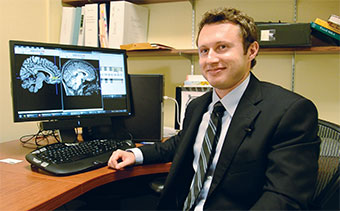Feature
Consumer Behavior
| USF News

Adam Craig, assistant professor of marketing in USF's College of Business, is researching brain activity in response to deceptive advertising. His work was recently published in the Journal of Marketing Research.
Photo by Katy Hennig | USF News
It's no secret that advertising can make you buy things you never thought you wanted, but can it actually change the way your brain works?
Adam Craig, assistant professor of marketing in the College of Business, is working with a team of neuroscience researchers to find out exactly what advertising does to a person's brain. The researchers are using brain imaging to analyze the way people respond to advertising and the financial decisions they make.
"The great thing about the neuroscience techniques we're using in these studies is we can measure some of those processes without people being able to tell us about it," Craig says.
Using a Functional Magnetic Resonance Imaging scanner or fMRI, the team analyzed data from brain scans in several advertising and consumer studies. The fMRI tracks the blood flow to specific areas of the brain and the statistical output is later analyzed to produce an image depicting the decision process.
In a recently published article in the Journal of Marketing Research, Craig and his fellow researchers analyzed the brain scans of consumers after they were exposed to deceptive advertising. The study pinpointed stages of the thought process behind deciding whether to believe a claim made by advertisers or which brand people choose to buy and why.
"This helps us figure out, okay, what parts of the brain are active at different times during exposure to advertising or whatever decisions people are faced with," Craig explains.

Functional Magnetic Resonance Imaging (fMRI) scans show blood flow to specific areas of the brain during decision making.
Photo by Katy Hennig | USF News
"We saw that there were really two stages of processing involved when people are seeing these potentially deceptive ads," he says. "A lot of what we're seeing in neuroscience and neuroeconomic research is that most of the decisions that we make are actually automatic. Most of the processes in the brain are automatic and are done without us actually being aware of it."
The fMRI research study provides insight to help us understand a little more about how consumers think about and make buying decisions. "As an informed consumer you have to first understand what the intentions of marketers are, and the specific mechanisms that they are using to influence us."
Craig, who teaches undergraduate-level courses in buyer behavior and marketing research, conducted and published the study with researchers at the University of South Carolina.